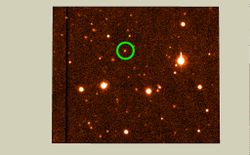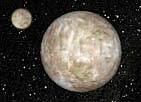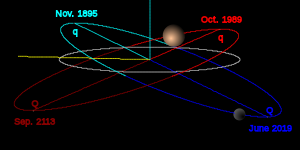90482 Orcus
 |
|
|
Discovery[1]
|
|
|---|---|
| Discovered by | M. Brown, C. Trujillo, D. Rabinowitz |
| Discovery date | February 17, 2004 |
|
Designations
|
|
| MPC designation | 90482 Orcus |
| Pronunciation | /ˈɔrkəs/ OR-kəs, Latin: Orcus |
| Named after | Orcus |
| Alternate name(s) | 2004 DW |
| Minor planet category |
Plutino[2][3] Plutoid candidate |
| Adjective | Orcean |
| Epoch November 30, 2008 (JD 2 454 800) | |
| Aphelion | 7 188.17 Gm (48.05 AU) |
| Perihelion | 4 535.80 Gm (30.32 AU) |
| Semi-major axis | 5 862.44 Gm (39.188 AU) |
| Eccentricity | 0.226 18 |
| Orbital period | 89 606 d (245.33 yr) |
| Mean anomaly | 164.68° |
| Inclination | 20.593° |
| Longitude of ascending node | 268.722° |
| Argument of perihelion | 72.474° |
| Satellites | Vanth |
|
Physical characteristics
|
|
| Dimensions | 946.3+74.1−72.3 km[4] 850 ± 90 km[5] |
| Mass | 6.32 ± 0.05 × 1020 kg (system)[6] |
| Mean density | 1.5 ± 0.3 g/cm³ (comparable to that of Charon)[6] |
| Equatorial surface gravity | ~0.2 m/s² |
| Escape velocity | ~0.42 km/s |
| Rotation period | 10.08 ± 0.01 hr[7] |
| Albedo | 0.28 ± 0.04[6] 19.75 +3.40−2.76%[4] |
| Temperature | <44 K[7] |
| Spectral type | (neutral)[7] B-V=0.68; V-R=0.37[8] |
| Apparent magnitude | 19.1 (opposition)[9][10] |
| Absolute magnitude (H) | 2.3[1] (2.27 ± 0.05)[6] Moon: 4.88 ± 0.05[6] |
90482 Orcus is a large Kuiper Belt object (KBO) with a large companion and is likely a dwarf planet. The discovery images of this object were acquired on February 17, 2004 by Michael Brown of Caltech, Chad Trujillo of the Gemini Observatory, and David Rabinowitz of Yale University. Precovery images as early as November 8, 1951 were later identified.[1]
Contents |
Orbit and rotation
Orcus is a large plutino (an object in 2:3 orbital resonance with Neptune).[2] Orcus's 247 year orbit is shaped similarly to Pluto's (both have perihelia above the ecliptic), but is differently oriented. Although at one point its orbit approaches that of Neptune, the resonance between the two bodies means that Orcus itself is always a great distance away from Neptune (there is always an angular separation of over 60 degrees between them). Over a 14,000 year period Orcus stays more than 18 AU from Neptune.[11] Because their mutual resonance with Neptune constrains Orcus and Pluto to remain in opposite phases of their otherwise very similar motions, Orcus is sometimes described as the "anti-Pluto".[12]
Orcus is currently 47.8 AU from the Sun[9] and will come to aphelion (farthest distance from the Sun) in 2019.[10] Simulations by the Deep Ecliptic Survey (DES) show that over the next 10 million years Orcus can acquire a perihelion distance (qmin) as small as 27.8 AU.[2]
The rotation period is not known. Different photometric surveys produced different result. Some of them show low amplitude variations with periods ranging from 7 to 21 hours. Others showed no variability.[13] The value obtained by Ortiz et al.—about 10 hours—is often cited in the literature.[7] The rotational poles of Orcus probably coincide with the orbital poles of its moon, Vanth. This means that Orcus is currently viewed pole-on, which can explain the near absence of any rotational modulation of its brightness.[13]
Name
Under the guidelines of the International Astronomical Union's naming conventions, objects with a similar size and orbit to that of Pluto are named after underworld deities. Accordingly, the discoverers suggested naming the object after Orcus, a god of the dead in Etruscan and Roman mythology. The name was also a private reference to the homonymous Orcas Island, where Brown's wife Diane had lived as a child and which they visit frequently.[14] Orcus was approved and published on November 22, 2004.
Physical characteristics
Size and magnitude
The absolute magnitude of Orcus is about 2.3[1] (comparable with the 2.6 of cubewano 50000 Quaoar). The detection of Orcus by the Spitzer space telescope in the far infrared[4] and by Herschel Space Telescope in submillimeter constrains its diameter to 850+90−90 km.[5] Orcus appears to have an albedo of about 22% to 34%,[5] which may be typical of trans-Neptunian objects approaching the 1000 km diameter range.[15]
In the magnitude and size estimates reported above it was assumed that Orcus is a singular object. The presence of a relatively large satellite (Vanth, see below) may change them considerably. The absolute magnitude of Vanth is estimated at 4.88, which means that it is about 11 times fainter than Orcus itself. If the albedos of both bodies are the same then the size of Orcus is about 900 km, while the size of Vanth is about 280 km. If, however, the albedo of Vanth is two times lower than that of Orcus then their sizes are comparable being 820 and 640 km, respectively.[6]
Mass
Since Orcus is known to be a binary system, the mass of the system has been estimated to be 6.32 ± 0.05 × 1020 kg, or about 3.8% the mass of largest known dwarf planet Eris.[6] How this mass is partitioned between Orcus and Vanth depends of their relative sizes. If the satellite's size is only 1/3d of that of the primary, then its mass is only 3% of the total mass. On the other hand, if the size of Vanth is comparable to that of Orcus (see above), then its mass can be as high as 1/3 of the total system mass or about 50% of the mass of Orcus.[6]
Spectra and surface

The first spectroscopic observations in 2004 showed that the visible spectrum of Orcus is flat (neutral in color) and featureless, while in the near-infrared there were moderately strong water absorption bands at 1.5 and 2.0 μm. Thus Orcus appeared to be different from other Trans-Neptunian objects like Ixion with red visible and often featureless infrared spectra.[16] Further Infrared observations in 2004 by the European Southern Observatory and the Gemini telescope give results consistent with mixtures of water ice and carbonaceous compounds, such as tholins.[8] The water and methane ices can cover no more than 50% and 30% of the surface, respectively.[17] This means the proportion of ice on the surface is less than on Charon, but similar to that on Triton.[17]
Later in 2008–2010 new infrared spectroscopic observations with a higher signal-to-noise ratio revealed additional spectral features. Among them are a deep water ice absorption band at 1.65 μm, which is an evidence of the crystalline water ice on the surface of Orcus, and a new absorption band at 2.22 μm. The origin of the latter feature is not completely clear. It can be caused either by ammonia/ammonium dissolved in the water ice or by methane/ethane ices.[7] The radiative transfer modeling showed that a mixture of water ice, tholins (as a darkening agent), ethane ice and ammonium ion (NH+44) provides the best match to the spectra, while a combination of water ice, tholins, methane ice and ammonia hydrate gives a slightly inferior result. On the other hand, a mixture of only ammonia hydrate, tholins and water ice failed to provide a satisfactory match.[13] So, as of 2010, the only reliably identified compounds on the surface of Orcus are crystalline water ice and, possibly, dark tholins. A firm identification of ammonia, methane and other hydrocarbons requires better infrared spectra.[13]
Comparison with other TNOs
Orcus straddles the edge for trans-Neptunian objects massive enough to retain volatiles such as methane on the surface.[13] The reflectance spectrum of Orcus shows the deepest water ice absorption of any Kuiper belt object (KBO) that is not associated with the Haumea collisional family.[6] The large icy satellites of Uranus have infrared spectra quite similar to that of Orcus.[6] Among other trans-Neptunian objects Pluto's moon Charon appears to be most similar to Orcus. It has a higher albedo but very similar visible and near-infrared spectra. Their densities are also similar and both have water ice rich surfaces.[7] Quaoar—a trans-Neptunian object of similar size—has strong water ice absorption features in its spectra but also has a very red color in the visible implying the presence of the ultrared matter on its surface. Dwarf planet Haumea and objects from its collisional family have much higher albedos and much deeper water absorption bands than Orcus. Finally, (208996) 2003 AZ84—another large object in 3:2 resonance with Neptune—has spectral properties very similar to Orcus.[13]
Cryovolcanism
The presence of crystalline water ice, and possibly ammonia ice may indicate that a renewal mechanism was active in the past on the surface of Orcus.[7] Ammonia so far has not been detected on any TNO or icy satellite of the outer planets other than Miranda.[7] The 1.65 μm band on Orcus is broad and deep (12%), as on Charon, Quaoar, Haumea, and icy satellites of giant planets.[7] On other hand the crystalline water ice on the surfaces of TNOs should be completely amorphized by the galactic and Solar radiation in about 10 million years.[7] Some calculations indicate that cryovolcanism, which is considered one of the possible renewal mechanisms, may indeed be possible for TNOs larger than about 1000 km.[13] Orcus may have experienced at least one such episode in the past, which turned the amorphous water ice on its surface into crystalline. The preferred type of volcanism may have been explosive aqueous volcanism driven by an explosive dissolution of methane from water–ammonia melts.[13]
Satellite

Using observations with the Hubble Space Telescope from November 13, 2005, Mike Brown and T.A. Suer detected a satellite.[18] The discovery of a satellite of Orcus was reported in IAUC 8812 on 22 February 2007.[19] The satellite was given the designation S/2005 (90482) 1 before later being named Vanth. It orbits Orcus in a nearly face-on circular orbit with an eccentricity less than 0.0036, and an orbital period of 9.53 days.[6] Vanth orbits only 8980 ± 20 km from Orcus and is too close to Orcus for ground-based spectroscopy to determine the surface composition of the satellite.[6] Mike Brown also suspects that like the Pluto-Charon system, Orcus and Vanth are likely tidally locked.[12] Vanth does not resemble other known collisional satellites because its spectrum is very different of that of primary, and may be a captured KBO.[12]
On March 23, 2009, Brown asked readers of his weekly column to suggest possible names for the satellite, with the best one to be submitted to the International Astronomical Union (IAU) on April 5.[12] The name Vanth, after the Etruscan goddess who guided the souls of the dead to the underworld, was eventually chosen from among a large pool of submissions.[14] This submission will be assessed by the IAU's Committee for Small Body Nomenclature, which will vote on whether to approve it, in accordance with the normal object naming procedures.[20]
References
- ↑ 1.0 1.1 1.2 1.3 1.4 "JPL Small-Body Database Browser: 90482 Orcus (2004 DW)". 2008-02-10 last obs. http://ssd.jpl.nasa.gov/sbdb.cgi?sstr=Orcus. Retrieved 2008-07-02.
- ↑ 2.0 2.1 2.2 Buie, Marc W. (2007-12-22). "Orbit Fit and Astrometric record for 90482". SwRI (Space Science Department). http://www.boulder.swri.edu/~buie/kbo/astrom/90482.html. Retrieved 2008-09-19.
- ↑ "MPEC 2009-E53 : DISTANT MINOR PLANETS (2009 MAR. 30.0 TT)". Minor Planet Center. 2009-03-11. http://www.cfa.harvard.edu/mpec/K09/K09E53.html. Retrieved 2009-03-25.
- ↑ 4.0 4.1 4.2 Stansberry, J.; Grundy, W.; Brown, M.; et al. (2007). Physical Properties of Kuiper Belt and Centaur Objects: Constraints from Spitzer Space Telescope. The Journal of Business. http://arxiv.org/abs/astro-ph/0702538v2.
- ↑ 5.0 5.1 5.2 T.L. Lim, J. Stansberry, T.G. Müller (2010). "“TNOs are Cool”: A survey of the trans-Neptunian region III. Thermophysical properties of 90482 Orcus and 136472 Makemake". Astronomy and Astrophysics 518: L148. doi:10.1051/0004-6361/201014701. http://adsabs.harvard.edu/abs/2010A%26A...518L.148L.
- ↑ 6.00 6.01 6.02 6.03 6.04 6.05 6.06 6.07 6.08 6.09 6.10 6.11 Brown, M.E.; Ragozzine, D.; Stansberry, J.; Fraser, W.C. (2010). "The size, density, and formation of the Orcus-Vanth system in the Kuiper belt". The Astronomical Journal 139: 2700–2705. doi:10.1088/0004-6256/139/6/2700. arXiv:0910.4784. http://adsabs.harvard.edu/abs/2010AJ....139.2700B.
- ↑ 7.0 7.1 7.2 7.3 7.4 7.5 7.6 7.7 7.8 7.9 Barucci, M. A.; Merlin; Guilbert; Bergh; Doressoundiram; et al. (2008). "Surface composition and temperature of the TNO Orcus". Astronomy and Astrophysics 479 (1): L13–L16. doi:10.1051/0004-6361:20079079. http://adsabs.harvard.edu/abs/2008A%26A...479L..13B.
- ↑ 8.0 8.1 de Bergh, C.; A. Delsanti, G. P. Tozzi, E. Dotto, A. Doressoundiram and M. A. Barucci (2005). "The Surface of the Transneptunian Object 9048 Orcus". Astronomy & Astrophysics 437: 1115–1120. doi:10.1051/0004-6361:20042533. http://adsabs.harvard.edu/abs/2005A&A...437.1115D.
- ↑ 9.0 9.1 "AstDys (90482) Orcus Ephemerides". Department of Mathematics, University of Pisa, Italy. http://hamilton.dm.unipi.it/astdys/index.php?pc=1.1.3.0&n=Orcus. Retrieved 2009-03-19.
- ↑ 10.0 10.1 "HORIZONS Web-Interface". JPL Solar System Dynamics. http://ssd.jpl.nasa.gov/horizons.cgi?find_body=1&body_group=sb&sstr=Orcus. Retrieved 2008-07-02.
- ↑ "MPEC 2004-D15 : 2004 DW". Minor Planet Center. 2004-02-20. http://www.cfa.harvard.edu/mpec/K04/K04D15.html. Retrieved 2009-01-30.
- ↑ 12.0 12.1 12.2 12.3 Michael E. Brown (2009-03-23). "S/2005 (90482) 1 needs your help". Mike Brown's Planets (blog). http://www.mikebrownsplanets.com/2009/03/s1-90482-2005-needs-your-help.html. Retrieved 2009-03-25.
- ↑ 13.0 13.1 13.2 13.3 13.4 13.5 13.6 13.7 A. Delsanti, F. Merlin, A. Guilbert–Lepoutre at al. (2010). "Methane, ammonia, and their irradiation products at the surface of an intermediate-size KBO? A portrait of Plutino (90482) Orcus". Astronomy and Astrophysics. doi:10.1086/430337. {[arxiv. http://adsabs.harvard.edu/abs/2010arXiv1006.4962D.}}
- ↑ 14.0 14.1 Michael E. Brown (2009-04-06). "Orcus Porcus". Mike Brown's Planets (blog). http://www.mikebrownsplanets.com/2009/04/orcus-porcus.html. Retrieved 2009-04-06.
- ↑ Wm. Robert Johnston (2008-09-17). "TNO/Centaur diameters and albedos". Johnston's Archive. http://www.johnstonsarchive.net/astro/tnodiam.html. Retrieved 2008-10-17.
- ↑ Fornasier, S.; Dotto, E.; Barucci, M.A. and Barbieri, C. (2004). "Water ice on the surface of the large TNO 2004 DW". Astronomy & Astrophysics 422: L43–L46. doi:10.1051/0004-6361:20048004. http://adsabs.harvard.edu/abs/2004A%26A...422L..43F.
- ↑ 17.0 17.1 Chadwick A. Trujillo, Michael E. Brown, David L. Rabinowitz, Thomas R. Geballe (2005). "Near Infrared Surface Properties of the Two Intrinsically Brightest Minor Planets (90377) Sedna and (90482) Orcus". The Astrophysical Journal 627: 1057–1065. doi:10.1086/430337. {[arxiv. http://adsabs.harvard.edu/abs/2005ApJ...627.1057T.}}
- ↑ Daniel W. E. Green (2007-02-22). "IAUC 8812: Sats OF 2003 AZ_84, (50000), (55637),, (90482)". International Astronomical Union Circular. http://www.cfa.harvard.edu/iauc/08800/08812.html. Retrieved 2009-03-26.
- ↑ Wm. Robert Johnston (2007-03-04). "(90482) Orcus". Johnston's Archive. http://www.johnstonsarchive.net/astro/astmoons/am-90482.html. Retrieved 2009-03-26.
- ↑ "Committee on Small Body Nomenclature: Names of Minor Planets". http://www.ss.astro.umd.edu/IAU/csbn/mpnames.shtml. Retrieved 2009-04-08.
External links and sources
- MPEC 2004-D09 announcing the discovery but attributing it to Raymond J. Bambery, Steven H. Pravdo, Michael D. Hicks, Kenneth J. Lawrence, Daniel MacDonald, Eleanor F. Helin and Robert Thicksten / NEAT
- MPEC 2004-D13 correcting MPEC 2004-D09
- Chad Trujillo's page on 2004 DW
- First BBC article
- AstDys orbital elements
- Orbital simulation from JPL (Java) / Ephemeris
|
|||||
|
|||||||||||
|
|||||||||||
|
||||||||
